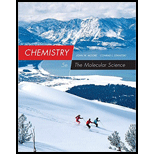
Interpretation:
In production of iron from its ores, the primary reducing agent that is used has to be given and balanced chemical equation for the reduction process has to be written.
Explanation of Solution
Most abundant
Iron present in the form of oxide is reduced to iron by the use of carbon monoxide. This can be represented in form of chemical equation as,
Balancing Iron atom: A total of two iron atoms is present in the reactant side while only one iron atom is present in the product side. Coefficient 2 is added before
Balancing Oxygen atom: A total of four oxygen atoms is present in the reactant side while only two oxygen atoms are present in the product side. Coefficient 3 is added before
As this have all the atoms of same kind equal on both sides of the equation, it is known as balanced chemical equation.
Want to see more full solutions like this?
Chapter 20 Solutions
Bundle: Chemistry: The Molecular Science, 5th, Loose-Leaf + OWLv2 with Quick Prep 24-Months Printed Access Card
- Using data in Appendix 1, estimate the temperature at which Fe2O3 can be reduced to iron, using hydrogen gas as a reducing agent (assume H2O(g) is the other product).arrow_forwardThree reactions very important to the semiconductor industry are The reduction of silicon dioxide to crude silicon, SiO2(s) + 2 C(s) → Si(s) + 2 CO(g) ΔrH° = 689.9 kJ/mol The formation of silicon tetrachloride from crude silicon, Si(s) + 2 Cl2(g) → SiCl4(g) ΔrH° = −657.01 kJ/mol The reduction of silicon tetrachloride to pure silicon with magnesium, SiCl4(g) + 2 Mg(s) → 2 MgCl2(s) + Si(s) ΔrH° = −625.6 kJ/mol Calculate the overall enthalpy change when 1.00 mol sand, SiO2, changes into very pure silicon by this series of reactions.arrow_forwardCopper(I) ion disproportionates to copper metal and copper(ll) ion. (See Study Question 99.) 2 Cu+(aq) Cu(s) + Cu2 + (aq) (a) What two half-reactions make up the disproportionation reaction? (b) Use values of the standard reduction potentials for the two half-reactions in part (a) to determine whether this disproportionation reaction is product-favored at equilibrium. (c) What is the equilibrium constant for this reaction? If you have a solution that initially contains 0.10 mol of Cu+ in 1.0 L of water, what are the concentrations of Cu+ and Cu2+ at equilibrium?arrow_forward
 Chemistry: The Molecular ScienceChemistryISBN:9781285199047Author:John W. Moore, Conrad L. StanitskiPublisher:Cengage Learning
Chemistry: The Molecular ScienceChemistryISBN:9781285199047Author:John W. Moore, Conrad L. StanitskiPublisher:Cengage Learning World of Chemistry, 3rd editionChemistryISBN:9781133109655Author:Steven S. Zumdahl, Susan L. Zumdahl, Donald J. DeCostePublisher:Brooks / Cole / Cengage Learning
World of Chemistry, 3rd editionChemistryISBN:9781133109655Author:Steven S. Zumdahl, Susan L. Zumdahl, Donald J. DeCostePublisher:Brooks / Cole / Cengage Learning Chemistry: Principles and PracticeChemistryISBN:9780534420123Author:Daniel L. Reger, Scott R. Goode, David W. Ball, Edward MercerPublisher:Cengage Learning
Chemistry: Principles and PracticeChemistryISBN:9780534420123Author:Daniel L. Reger, Scott R. Goode, David W. Ball, Edward MercerPublisher:Cengage Learning- Chemistry: Matter and ChangeChemistryISBN:9780078746376Author:Dinah Zike, Laurel Dingrando, Nicholas Hainen, Cheryl WistromPublisher:Glencoe/McGraw-Hill School Pub Co
 Chemistry & Chemical ReactivityChemistryISBN:9781337399074Author:John C. Kotz, Paul M. Treichel, John Townsend, David TreichelPublisher:Cengage Learning
Chemistry & Chemical ReactivityChemistryISBN:9781337399074Author:John C. Kotz, Paul M. Treichel, John Townsend, David TreichelPublisher:Cengage Learning Chemistry & Chemical ReactivityChemistryISBN:9781133949640Author:John C. Kotz, Paul M. Treichel, John Townsend, David TreichelPublisher:Cengage Learning
Chemistry & Chemical ReactivityChemistryISBN:9781133949640Author:John C. Kotz, Paul M. Treichel, John Townsend, David TreichelPublisher:Cengage Learning





